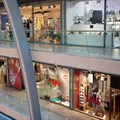Retail property's competitive disadvantage - an overhang from pre-2008

However, that doesn’t mean that the retail property sector doesn’t have its own sources of pressure. It arguably has a different key source of pressure in the form of an affordability challenge. Its relative affordability challenge is arguably far greater than that facing the more affordable industrial property markets, as the online retail era arrives.
Retail property’s “golden era”
Going back in data history, it would appear that retail property’s “golden era” started somewhere in the 1990s and continued all the way to 2007, in which period its affordability deteriorated at a significantly more rapid rate than that of the office and industrial property sectors.
At the beginning of 1990, Rode’s National Average Regional Shopping Centre Capitalisation (Cap) rate was higher than that of De-centralised A-Grade Office Leasebacks (+0.2 of a percentage point higher), and nearer to the Prime Industrial Cap Rate (-0.8 of a percentage point below it) compared to today (-1.3 percentage points below).
The move stronger by Regional Shopping Centre Cap Rates, relative to the Office and Industrial Cap Rates came in the 1990s and early-2000s, the biggest gap it managed to open up on the other two sectors being in the first half of 2005 (-2.9 and -2.3 percentage points below the cap rates of office and industrial respectively).
2005 was around the peak of one of the big partly credit-driven consumer booms in history, so a superior performance in retail property would be hardly surprising.
During that period, the “retail and wholesale trade, catering and accommodation” (“trade”) sector’s GVA (gross value added) growth performance outpaced the key “driving” sector of industrial property, i.e. manufacturing GVA, and that of office property, i.e., employment trends in the finance, real estate and business services (FREBS) sector.
From just after the early-1990s recession, as from early-1993 to the first quarter of 2008 (just prior to the financial crisis recession), the “trade” sector’s GVA increased cumulatively by 84.8%, while that of manufacturing by 78.8% and FREBS sector employment by a lesser 49%. From 1993 to end-2019, the respective cumulative growth rates were 119.74%, 66.3% and 52.6%.
In short, over the past three decades, retail property has not often been "handicapped" relative to the other two major sectors with regard to the relative strength of its key economy-related growth drivers.
Retail property boom period ultimately lead to relative in-affordability
However, we believe that a significantly bigger deterioration in this sector’s affordability, relative to the other two sectors, has become its “achilles heel”, at a time when the economy is weak and the challenge from online retail is intensifying.
Most of the strong retail property affordability deterioration came prior to the 2008/9 Global Financial Crisis Recession.
In real terms, adjusting for broad economy-wide inflation using a GDP inflation measure, operating costs/square metre rose cumulatively by 97% from 1995 (the year that MSCI data starts) to 2004. And when the big Eskom tariff hikes started around 2008/9, the sharp rise started again, real operating cost reaching a cumulative 1995-2012 real growth rate of 141.1%. By that year, cumulative real operating cost growth/square metre for industrial was a lesser 98.6% for industrial property and a mere 17.8% for office space.
The “pricing power” of landlords in retail property was very strong in the boom years prior to 2008, and through rent and recoveries they could see to it that despite stronger operating cost growth than the other major sectors, retail property real net operating income growth also far outstripped the other two major sectors.
From 1995 to 2007, retail property net operating income growth in real terms (also adjusted using GDP inflation) grew cumulatively by 110.3%, while that of office space was a far lesser 36.7% and industrial property 16.6%.
2008-2019, retail property cumulatively no longer “outperformed”
But from 2008 onward, one could see a lack of progress in the retail property sector’s ability to grow real net operating income further.
After a recession-driven 2008-2011 dip in real net income, influenced in part by the start of very significant electricity tariff hikes, the retail property sector’s real net operating income made something of a comeback to reach a similar level to 2007 as at 2019, cumulative growth from 2007 to 2019 being a slightly negative -2.2%.
By comparison, the less “inflated” office space saw positive cumulative real growth in net operating income of 12.8% over this period and industrial property an even more significant +24%.
We believe, therefore, that after way outpacing the office and industrial property classes in terms of affordability deteriorations for tenants in the retail property space, from 1995 to 2007 on a cumulative basis, retail property was already running into the constraint of its own relative in-affordability from 2008 onwards, and was unable to cumulatively grow its real net operating income over a period of 12 years from then onward.
By comparison, office and industrial still had some space to growth their real net operating incomes over the 2007 to 2019 period, even though their relevant driving economic sectors did not noticeably outperform retail sector GVA growth during this period.
Similarly, real growth in retail property’s average capital value/square metre has outpaced the office and industrial sectors by far from 1995 to 2019, rising cumulatively by 99%, compared to industrial property’s 55.2% and office’s 32.2%.
But that outperformance was achieved up to 2007, and from 2007’s peak to 2019 its cumulative real changes was a negative -3.1%, compared with an office property positive +8.7% and industrial property’s +22.7% over the same period.
Conclusion
Recessionary conditions that may linger in the post-lockdown phase of the coronavirus crisis “era” are expected to exert direct pressure on all the major property classes, but probably more so on industrial property (given its link to the highly-cyclical manufacturing sector) and less so on retail property.
But this doesn’t mean that retail property has less risks. Retail property’s key risk lies in its relative "in-affordability” compared with the office and industrial property classes. The big retail affordability deterioration came during the sector’s “glory years” through a part of the 1990s and up to 2007.
But since 2008, retail property has “underperformed”, especially relative to industrial property, perhaps beginning to battle under the weight of its own relative in-affordability. We expect retail property’s underperformance relative to especially industrial property to continue in the immediate aftermath of the Covid-19 crisis, a reflection of the sector’s relative in-affordability ever since its pre-2008 “golden years”.




